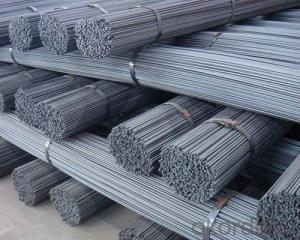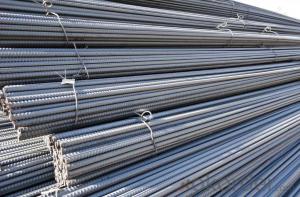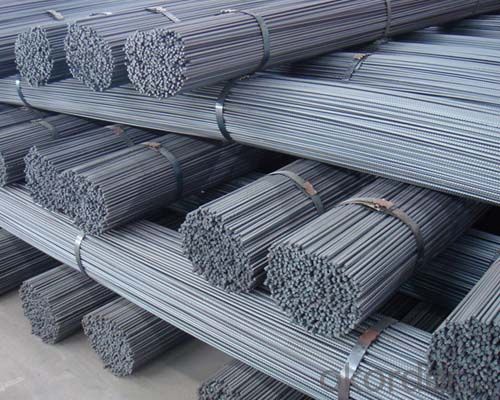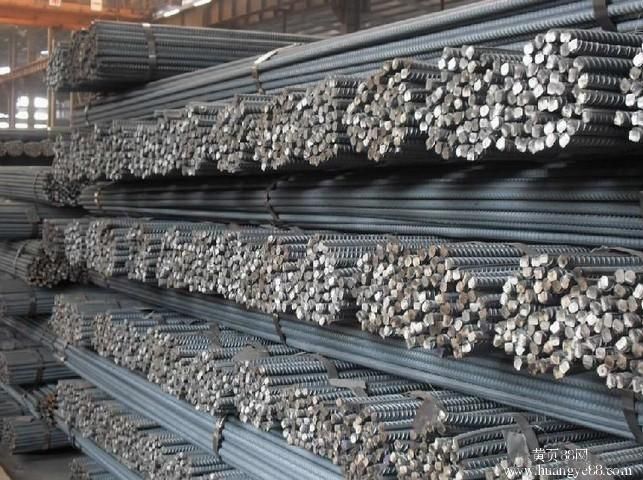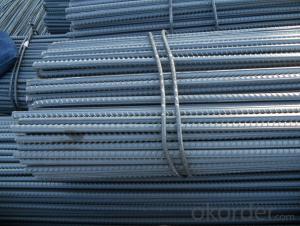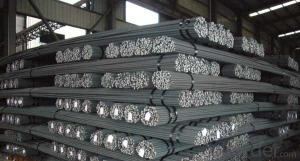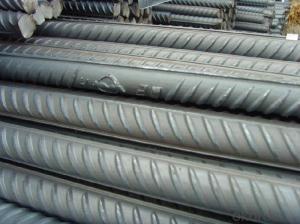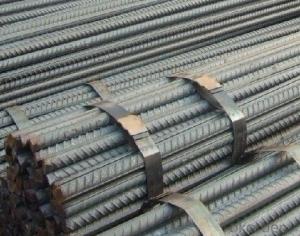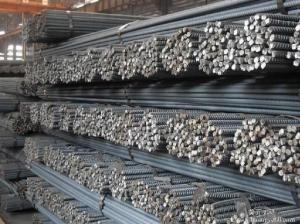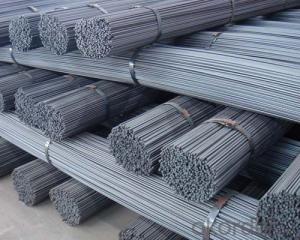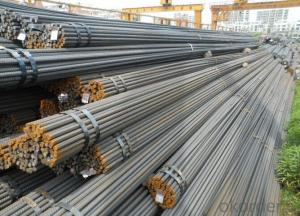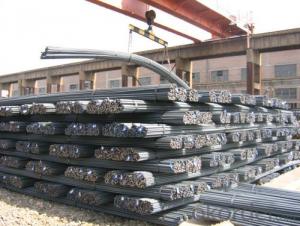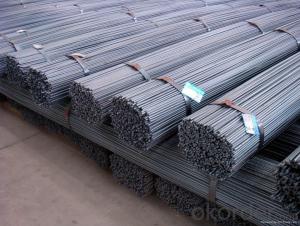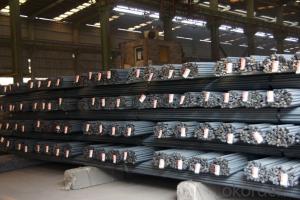Deformed bars in Grade HRB400 with Best Quality
- Loading Port:
- Tianjin
- Payment Terms:
- TT OR LC
- Min Order Qty:
- 25 m.t.
- Supply Capability:
- 100000 m.t./month
OKorder Service Pledge
OKorder Financial Service
You Might Also Like
Product Description:
Specifications of HRB400 Deformed Steel Bar:
Standard | GB | HRB400 | |
Diameter | 6mm,8mm,10mm,12mm,14mm,16mm,18mm,20mm, 22mm,25mm,28mm,32mm,36mm,40mm,50mm | ||
Length | 6M, 9M,12M or as required | ||
Place of origin | Hebei, China mainland | ||
Advantages | exact size, regular package, chemical and mechanical properties are stable. | ||
Type | Hot rolled deformed steel bar | ||
Brand name | DRAGON | ||
Chemical Composition: (Please kindly find our chemistry of our material based on HRB500 as below for your information)
Grade | Technical data of the original chemical composition (%) | ||||||
C | Mn | Si | S | P | V | ||
HRB400 | ≤0.25 | ≤1.60 | ≤0.80 | ≤0.045 | ≤0.045 | 0.04-0.12 | |
Physical capability | |||||||
Yield Strength (N/cm²) | Tensile Strength (N/cm²) | Elongation (%) | |||||
≥400 | ≥570 | ≥14 | |||||
Theoretical weight and section area of each diameter as below for your information:
Diameter(mm) | Section area (mm²) | Mass(kg/m) | Weight of 12m bar(kg) |
6 | 28.27 | 0.222 | 2.664 |
8 | 50.27 | 0.395 | 4.74 |
10 | 78.54 | 0.617 | 7.404 |
12 | 113.1 | 0.888 | 10.656 |
14 | 153.9 | 1.21 | 14.52 |
16 | 201.1 | 1.58 | 18.96 |
18 | 254.5 | 2.00 | 24 |
20 | 314.2 | 2.47 | 29.64 |
22 | 380.1 | 2.98 | 35.76 |
25 | 490.9 | 3.85 | 46.2 |
28 | 615.8 | 4.83 | 57.96 |
32 | 804.2 | 6.31 | 75.72 |
36 | 1018 | 7.99 | 98.88 |
40 | 1257 | 9.87 | 118.44 |
50 | 1964 | 15.42 | 185.04 |
Usage and Applications of HRB400 Deformed Steel Bar:
Deformed bar is widely used in buildings, bridges, roads and other engineering construction. Big to highways, railways, bridges, culverts, tunnels, public facilities such as flood control, dam, small to housing construction, beam, column, wall and the foundation of the plate, deformed bar is an integral structure material. With the development of world economy and the vigorous development of infrastructure construction, real estate, the demand for deformed bar will be larger and larger..
Packaging & Delivery of HRB400 Deformed Steel Bar:
Packaging Detail: products are packed in bundle and then shipped by container or bulk vessel, deformed bar is usually naked strapping delivery, when storing, please pay attention to moisture proof. The performance of rust will produce adverse effect.
Each bundle weight: 2-3MT, or as required
Payment term: TT or L/C
Delivery Detail: within 45 days after received advanced payment or LC.
Label: to be specified by customer, generally, each bundle has 1-2 labels
Trade terms: FOB, CFR, CIF
- Q: What is the impact of steel rebars on the carbon footprint of a building?
- Steel rebars have a significant impact on the carbon footprint of a building due to their production process and overall lifecycle. The manufacturing of steel rebars involves the extraction of raw materials, such as iron ore, and the energy-intensive process of smelting and refining them into steel. This phase alone contributes to greenhouse gas emissions and consumes substantial amounts of energy. Additionally, the transportation and construction of steel rebars also contribute to the carbon footprint of a building. The transportation process involves the use of fossil fuels, which release carbon dioxide into the atmosphere. Furthermore, the construction phase requires heavy machinery and equipment, which also rely on fossil fuels, further adding to the carbon emissions. Moreover, the carbon footprint of steel rebars extends beyond the construction phase. Steel is highly durable and can last for decades, but it also requires maintenance and potential replacement over time. These activities, such as repairs or demolitions, incur additional carbon emissions due to transportation, energy consumption, and waste management. However, it is important to note that steel rebars can offer environmental benefits when used in high-performance buildings or sustainable construction practices. For instance, steel is recyclable, and reusing steel rebars can significantly reduce the carbon footprint associated with their production. Additionally, steel rebars provide structural strength, allowing for the construction of taller and more efficient buildings that can potentially reduce energy consumption in the long run. To minimize the carbon footprint of a building, it is essential to consider alternative materials, such as recycled steel or other low-carbon materials, in the construction process. Additionally, implementing energy-efficient practices throughout the building's lifecycle, including reduced energy consumption and improved waste management, can further mitigate the environmental impact of steel rebars.
- Q: What is the role of steel rebars in reducing concrete creep?
- Steel rebars play a crucial role in reducing concrete creep. Concrete creep refers to the gradual deformation or movement of concrete over time under sustained loading. This phenomenon occurs due to the long-term effects of stress and environmental factors on the concrete structure. By incorporating steel rebars into concrete structures, the creep behavior of concrete is significantly reduced. Steel rebars are high-strength reinforcement bars that are embedded within the concrete to enhance its structural integrity and durability. They provide tensile strength to counteract the tensile stresses that can cause concrete to creep. When concrete is subjected to sustained loads, such as the weight of a building or a bridge, it experiences internal stresses that can lead to creep. However, the presence of steel rebars helps to distribute these stresses more evenly throughout the structure. The rebars act as a reinforcement, absorbing and redistributing the tensile forces, thus minimizing the deformation of the concrete. Additionally, steel rebars also improve the bond between concrete and the reinforcement. This bond is essential for transferring the tensile forces from the concrete to the rebars and ensuring that they work together as a composite material. The strong bond between concrete and rebars prevents the formation of cracks, which can further contribute to creep. Furthermore, steel rebars also enhance the overall stiffness and rigidity of the concrete structure. This increased stiffness helps to resist the deformation caused by creep, maintaining the integrity and stability of the structure over time. In summary, the role of steel rebars in reducing concrete creep is vital. They provide tensile strength, distribute internal stresses, improve the bond between concrete and reinforcement, and enhance the overall stiffness of the structure. By incorporating steel rebars, engineers can effectively mitigate the effects of creep and ensure the long-term performance and durability of concrete structures.
- Q: How do steel rebars provide flexibility to concrete structures?
- Concrete structures can benefit from the flexibility provided by steel rebars in multiple ways. Firstly, the addition of steel rebars reinforces the concrete, enhancing its tensile strength. While concrete is strong in compression, it is weak in tension. By incorporating steel rebars, the concrete becomes more resistant to bending and cracking, as the rebars can absorb the tensile forces that would otherwise cause failure. This reinforcement enables concrete structures to withstand heavier loads and offers flexibility by preventing excessive deformation or collapse. Secondly, steel rebars can be utilized to construct a reinforced concrete frame, which boosts the overall flexibility of the structure. When embedded in the concrete, the rebars form an interconnected network of elements that distribute applied loads more evenly. This network acts as a flexible skeleton capable of adapting to various stresses, such as temperature changes, ground movements, or dynamic forces. As a result, the structure can accommodate minor movements or vibrations without sustaining significant damage. Additionally, steel rebars can be strategically positioned in areas where additional flexibility is required. For instance, in regions prone to seismic activity, rebars can be concentrated in critical areas like building joints or corners. This placement helps dissipate the energy generated during an earthquake, allowing the structure to deform and absorb seismic forces without collapsing. The flexibility provided by steel rebars enhances the seismic resistance of the concrete structure. To summarize, steel rebars contribute to the flexibility of concrete structures by increasing their tensile strength, creating a reinforced concrete frame, and allowing for strategic placement to enhance specific areas of flexibility. This flexibility enables concrete structures to withstand diverse loads, adapt to various stresses, and improve their overall strength and durability.
- Q: How do steel rebars resist shear forces in concrete structures?
- Steel rebars resist shear forces in concrete structures by providing reinforcement and strengthening to the concrete. When concrete is subjected to shear forces, such as those caused by lateral loads or earthquakes, it tends to crack and fail along a diagonal plane. However, by including steel rebars within the concrete, these forces are resisted and distributed more effectively. The steel rebars act as a structural element that enhances the overall strength and stability of the concrete structure. They are typically placed in areas where shear forces are expected to be high, such as in beams, columns, and slabs. The rebars are placed in a crisscross pattern, forming a grid-like structure within the concrete. When shear forces act on the concrete, the rebars resist the tendency of the concrete to crack and separate by transferring the load across the cracks. The rebars act as a tension reinforcement, providing additional strength and preventing the concrete from failing. They distribute the shear forces more evenly, reducing the concentration of stress in specific areas and increasing the overall structural integrity. The bond between the steel rebars and the surrounding concrete is crucial for their effective resistance to shear forces. The rebars are designed with ridges or deformations along their surface to improve the bond strength with the concrete. This bond ensures that the rebars and the concrete act together as a single unit, allowing the transfer of shear forces from the concrete to the steel rebars. In summary, steel rebars resist shear forces in concrete structures by reinforcing and strengthening the concrete, distributing the shear forces more effectively, and preventing the concrete from cracking and failing. They provide additional strength, enhance the structural integrity, and ensure the overall stability of the concrete structure.
- Q: How are steel rebars different from other types of reinforcement?
- The composition and strength of steel rebars set them apart from other types of reinforcement. Unlike fiberglass or carbon fiber, which are commonly used for reinforcement, steel rebars are made of steel, giving them exceptional strength and durability. One notable distinction between steel rebars and other reinforcement types is their capacity to withstand high tensile forces. Steel possesses a high tensile strength, allowing it to resist stretching or being pulled apart. This characteristic makes steel rebars ideal for reinforcing concrete structures that experience significant tensile loads, such as bridges, buildings, and highways. Another unique feature of steel rebars is their ability to bond effectively with concrete. The ridges or deformations on the rebars' surface enhance adhesion between the steel and concrete, facilitating efficient load transfer. This bond ensures that the concrete and steel work together as a composite material, enhancing the overall strength and structural integrity of the reinforced concrete structure. Steel rebars also offer versatility in terms of shape and size. They are available in various diameters, lengths, and shapes, including round, square, and deformed. This variety allows engineers to select the most suitable rebar type based on the specific requirements of the construction project. Moreover, steel rebars exhibit high resistance to corrosion, particularly when properly coated or protected. This corrosion resistance ensures the longevity and durability of the reinforced concrete structure, even in harsh environments or exposure to moisture. In conclusion, steel rebars stand out from other reinforcement types due to their exceptional strength, ability to withstand high tensile forces, excellent bond with concrete, versatility in shape and size, and resistance to corrosion. These qualities make steel rebars the most commonly used and preferred choice for reinforcing concrete structures in the construction industry.
- Q: What does "4esg25" mean on thread steel?
- The letters on the reinforcement are registered plant names or trademarks. The top figures on the bar represent the grade of the reinforcement, such as 3 for grade 2 steel, 4 for grade 3 steel, and 5 for grade 4 steel. The numbers in the back represent the specifications of the bars, and the letters between grades and specifications represent the steel manufacturer.
- Q: How are steel rebars labeled or marked for identification?
- Steel rebars are typically labeled or marked for identification through various methods such as embossing, stamping, or using colored paint. These labels often include important information like the grade of steel, manufacturer's name or logo, the bar size, and the production date.
- Q: What are the guidelines for proper cover thickness of steel rebars in concrete structures?
- Ensuring the durability and structural integrity of concrete structures heavily relies on adhering to the guidelines for proper cover thickness of steel rebars. Below are the general guidelines to consider: 1. Local building codes and regulations: It is crucial to refer to the building codes and regulations applicable in the area as they provide detailed specifications for the cover thickness of steel rebars in concrete structures. These codes are based on extensive research, testing, and engineering standards, guaranteeing the safety and longevity of the structure. 2. Environmental factors: The environmental conditions in which the structure will be situated should be taken into account. Variables like exposure to corrosive substances, humidity, temperature fluctuations, and seismic activity can influence the necessary cover thickness. In more challenging environments, it may be necessary to use thicker covers to adequately protect against corrosion. 3. Rebar diameter: The diameter of the steel rebars also influences the appropriate cover thickness. Smaller diameter rebars may require a thinner cover compared to larger diameter rebars to maintain strength and prevent corrosion. 4. Structural design considerations: When determining the cover thickness, the design of the concrete structure, including its load-bearing capacity, reinforcement layout, and anticipated stresses, must be considered. Consulting with a structural engineer is vital to accurately determine the cover thickness based on the specific design requirements. 5. Concrete quality: The quality and type of concrete used in construction also impact the necessary cover thickness. Higher-grade concrete with superior corrosion resistance may allow for a thinner cover, while lower-grade concrete may necessitate a thicker cover to provide adequate protection to the rebars. 6. Construction process: The construction process itself can affect the cover thickness. Proper placement and compaction of the concrete, as well as careful handling of the rebars during installation, are essential to maintain the desired cover thickness. Construction workers and contractors should receive training and possess knowledge of the correct procedures to achieve the appropriate cover thickness. Adhering to these guidelines is crucial to ensure the long-term durability, safety, and performance of concrete structures. It is always recommended to consult with a qualified structural engineer or other relevant professionals to determine the specific cover thickness requirements for a particular project.
- Q: What are the different types of steel rebars used in underground constructions?
- There are several types of steel rebars used in underground constructions, including epoxy-coated rebars, stainless steel rebars, and galvanized rebars. These different types of rebars offer various benefits such as increased corrosion resistance, improved durability, and enhanced structural strength, making them suitable for different underground applications.
- Q: Can steel rebars be used in structures with aggressive chemical exposure?
- Steel rebars can be used in structures with aggressive chemical exposure, but their performance may be compromised depending on the specific chemicals involved. It is crucial to select the appropriate type of steel with corrosion-resistant properties or use protective coatings to prevent degradation and maintain structural integrity. Additionally, regular maintenance and monitoring are required to ensure the rebars' durability in such environments.
Send your message to us
Deformed bars in Grade HRB400 with Best Quality
- Loading Port:
- Tianjin
- Payment Terms:
- TT OR LC
- Min Order Qty:
- 25 m.t.
- Supply Capability:
- 100000 m.t./month
OKorder Service Pledge
OKorder Financial Service
Similar products
Hot products
Hot Searches
Related keywords
